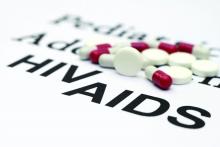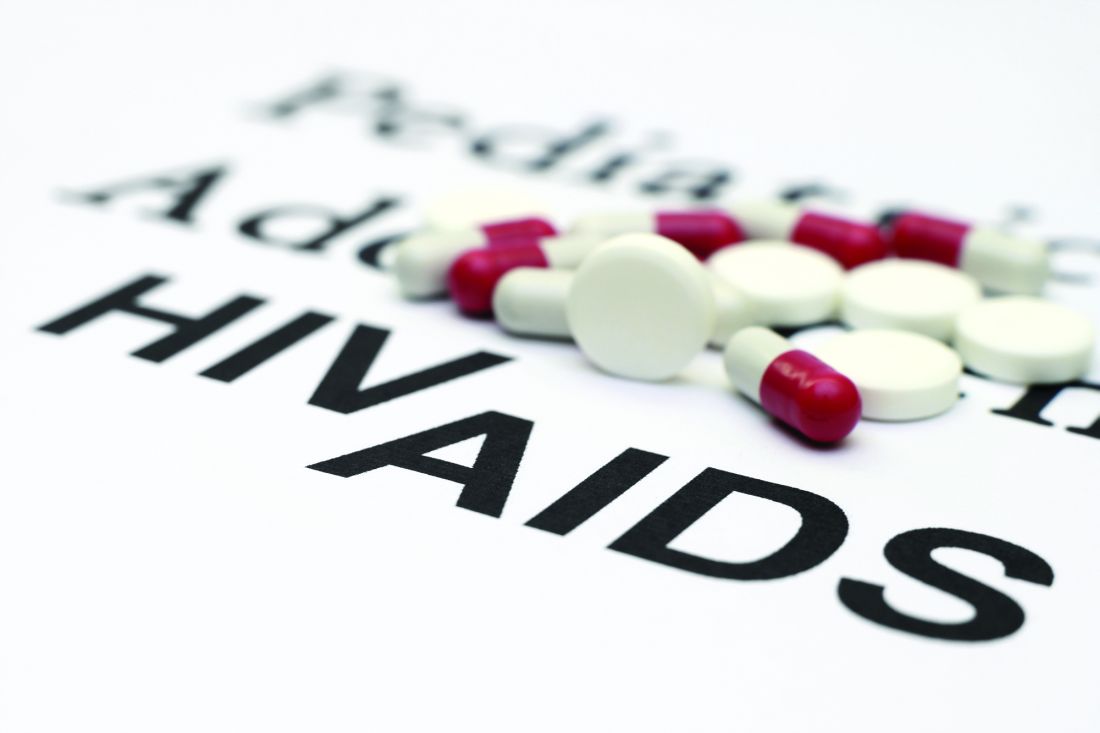User login
In combination with an optimized background regimen, the humanized IgG4 monoclonal antibody ibalizumab can reduce viral load and increase CD4 counts in patients with multidrug-resistant HIV type 1 (MDR HIV-1), according to a study published in the New England Journal of Medicine. It does so by binding noncompetitively to CD4 receptors, which can thereby block HIV-1 entry.
TMB-301 (NCT02475629) was a 24-week, open-label, single-group, phase 3 study that included patients with MDR HIV-1. During July 2015 to October 2016, patients first continued on their previous treatment for 7 days, then were given a 2,000-mg loading dose of ibalizumab as monotherapy, and then continued on 800 mg ibalizumab every 14 days plus an individualized regimen that was optimized based on patients’ past treatments for the remainder of the study period.
The primary endpoint was how many patients experienced a decrease in viral load of at least 0.5 log10 copies/mL from baseline to day 14 – that is, after the 7-day control period plus the 7-days ibalizumab monotherapy period. This occurred in 33 of the 40 patients (83%; 95% confidence interval, 67%-93%; P less than .001); in fact, 60% of patients (n = 24) experienced a decrease of at least 1.0 log10 copies/mL during that period, and the mean and median reductions were 1.1 log10 copies/mL. One secondary end point was increase in CD4 counts: The mean increase was 62 cells/mcL, although smaller increases were seen among patients with lower starting counts. Of the 10 patients who exhibited virologic failure or rebound, 9 showed less susceptibility to ibalizumab at week 25 than they had shown at baseline.
At least one adverse event was seen in 32 patients (80%), although most (87%) of those events were mild to moderate in severity, such as diarrhea (20%) and nausea, fatigue, pyrexia, rash, and dizziness (13% each). More serious events (grade 3 or 4) were seen in 28% of patients (n = 11); serious events were seen in nine patients – including immune reconstitution inflammatory syndrome in one. Four patients died during the study, although none of the deaths were believed to have been related to treatment with ibalizumab.
The investigators noted that the study’s limitations – its small size, uncontrolled design, and limited time for analyzing secondary and safety endpoints – were largely related to small number of patients with MDR HIV-1. The investigators noted that, in accordance with HIV treatment guidelines, patients who experience resistance-related treatment failure should be started on a regimen that includes at least two fully active agents; the investigators suggest that the addition of a drug like ibalizumab provides new opportunities for effective treatments in these situations.
This study was originally presented at the Conference on Retroviruses & Opportunistic Infections in partnership with the International Antiviral Society.
The study was supported by the Orphan Products Clinical Trials Grants Program of the Food and Drug Administration and TaiMed, which developed ibalizumab. The authors disclosed ties to various industry entities, including grants, personal fees, nonfinancial support, and other forms of support from TaiMed.
SOURCE: Emu B et al. New Engl J Med. 2018 Aug 16;379(9):645-54.
In combination with an optimized background regimen, the humanized IgG4 monoclonal antibody ibalizumab can reduce viral load and increase CD4 counts in patients with multidrug-resistant HIV type 1 (MDR HIV-1), according to a study published in the New England Journal of Medicine. It does so by binding noncompetitively to CD4 receptors, which can thereby block HIV-1 entry.
TMB-301 (NCT02475629) was a 24-week, open-label, single-group, phase 3 study that included patients with MDR HIV-1. During July 2015 to October 2016, patients first continued on their previous treatment for 7 days, then were given a 2,000-mg loading dose of ibalizumab as monotherapy, and then continued on 800 mg ibalizumab every 14 days plus an individualized regimen that was optimized based on patients’ past treatments for the remainder of the study period.
The primary endpoint was how many patients experienced a decrease in viral load of at least 0.5 log10 copies/mL from baseline to day 14 – that is, after the 7-day control period plus the 7-days ibalizumab monotherapy period. This occurred in 33 of the 40 patients (83%; 95% confidence interval, 67%-93%; P less than .001); in fact, 60% of patients (n = 24) experienced a decrease of at least 1.0 log10 copies/mL during that period, and the mean and median reductions were 1.1 log10 copies/mL. One secondary end point was increase in CD4 counts: The mean increase was 62 cells/mcL, although smaller increases were seen among patients with lower starting counts. Of the 10 patients who exhibited virologic failure or rebound, 9 showed less susceptibility to ibalizumab at week 25 than they had shown at baseline.
At least one adverse event was seen in 32 patients (80%), although most (87%) of those events were mild to moderate in severity, such as diarrhea (20%) and nausea, fatigue, pyrexia, rash, and dizziness (13% each). More serious events (grade 3 or 4) were seen in 28% of patients (n = 11); serious events were seen in nine patients – including immune reconstitution inflammatory syndrome in one. Four patients died during the study, although none of the deaths were believed to have been related to treatment with ibalizumab.
The investigators noted that the study’s limitations – its small size, uncontrolled design, and limited time for analyzing secondary and safety endpoints – were largely related to small number of patients with MDR HIV-1. The investigators noted that, in accordance with HIV treatment guidelines, patients who experience resistance-related treatment failure should be started on a regimen that includes at least two fully active agents; the investigators suggest that the addition of a drug like ibalizumab provides new opportunities for effective treatments in these situations.
This study was originally presented at the Conference on Retroviruses & Opportunistic Infections in partnership with the International Antiviral Society.
The study was supported by the Orphan Products Clinical Trials Grants Program of the Food and Drug Administration and TaiMed, which developed ibalizumab. The authors disclosed ties to various industry entities, including grants, personal fees, nonfinancial support, and other forms of support from TaiMed.
SOURCE: Emu B et al. New Engl J Med. 2018 Aug 16;379(9):645-54.
In combination with an optimized background regimen, the humanized IgG4 monoclonal antibody ibalizumab can reduce viral load and increase CD4 counts in patients with multidrug-resistant HIV type 1 (MDR HIV-1), according to a study published in the New England Journal of Medicine. It does so by binding noncompetitively to CD4 receptors, which can thereby block HIV-1 entry.
TMB-301 (NCT02475629) was a 24-week, open-label, single-group, phase 3 study that included patients with MDR HIV-1. During July 2015 to October 2016, patients first continued on their previous treatment for 7 days, then were given a 2,000-mg loading dose of ibalizumab as monotherapy, and then continued on 800 mg ibalizumab every 14 days plus an individualized regimen that was optimized based on patients’ past treatments for the remainder of the study period.
The primary endpoint was how many patients experienced a decrease in viral load of at least 0.5 log10 copies/mL from baseline to day 14 – that is, after the 7-day control period plus the 7-days ibalizumab monotherapy period. This occurred in 33 of the 40 patients (83%; 95% confidence interval, 67%-93%; P less than .001); in fact, 60% of patients (n = 24) experienced a decrease of at least 1.0 log10 copies/mL during that period, and the mean and median reductions were 1.1 log10 copies/mL. One secondary end point was increase in CD4 counts: The mean increase was 62 cells/mcL, although smaller increases were seen among patients with lower starting counts. Of the 10 patients who exhibited virologic failure or rebound, 9 showed less susceptibility to ibalizumab at week 25 than they had shown at baseline.
At least one adverse event was seen in 32 patients (80%), although most (87%) of those events were mild to moderate in severity, such as diarrhea (20%) and nausea, fatigue, pyrexia, rash, and dizziness (13% each). More serious events (grade 3 or 4) were seen in 28% of patients (n = 11); serious events were seen in nine patients – including immune reconstitution inflammatory syndrome in one. Four patients died during the study, although none of the deaths were believed to have been related to treatment with ibalizumab.
The investigators noted that the study’s limitations – its small size, uncontrolled design, and limited time for analyzing secondary and safety endpoints – were largely related to small number of patients with MDR HIV-1. The investigators noted that, in accordance with HIV treatment guidelines, patients who experience resistance-related treatment failure should be started on a regimen that includes at least two fully active agents; the investigators suggest that the addition of a drug like ibalizumab provides new opportunities for effective treatments in these situations.
This study was originally presented at the Conference on Retroviruses & Opportunistic Infections in partnership with the International Antiviral Society.
The study was supported by the Orphan Products Clinical Trials Grants Program of the Food and Drug Administration and TaiMed, which developed ibalizumab. The authors disclosed ties to various industry entities, including grants, personal fees, nonfinancial support, and other forms of support from TaiMed.
SOURCE: Emu B et al. New Engl J Med. 2018 Aug 16;379(9):645-54.
FROM THE NEW ENGLAND JOURNAL OF MEDICINE

